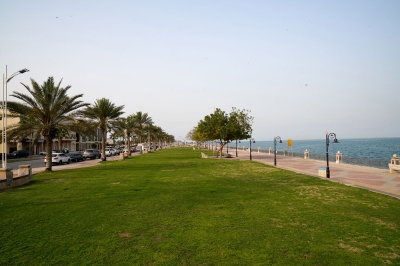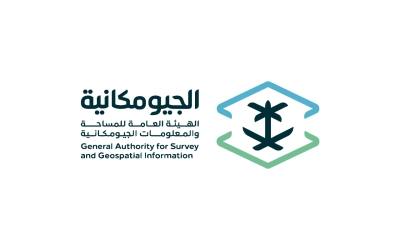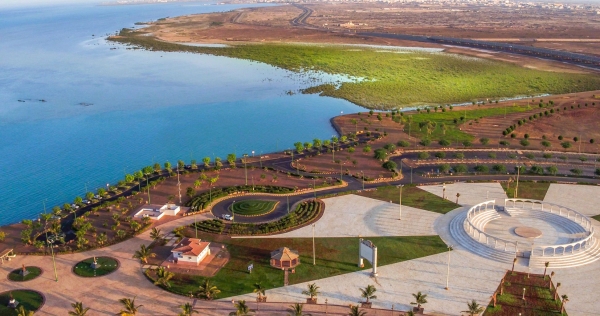
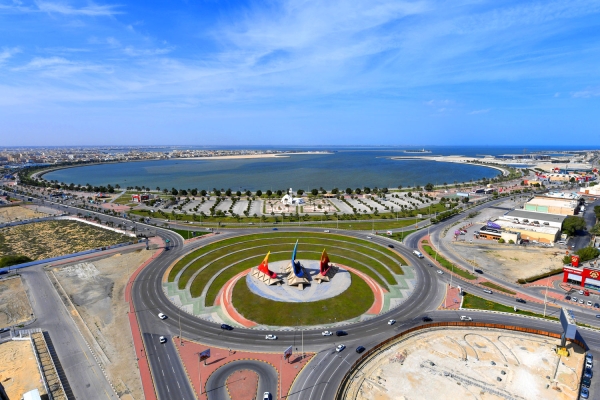
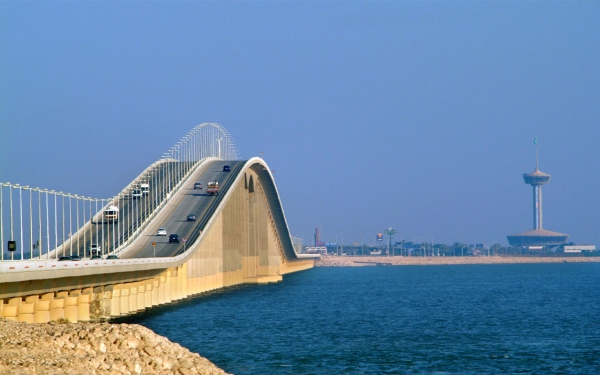
The Coasts or beaches of the Kingdom of Saudi Arabia represent the extension of the Kingdom over the three bodies of water: the Arabian Gulf to the east, the Red Sea to the west, and the Gulf of Aqaba to the northwest, with a total length of up to 3,800 km.
Borders of the beaches and coasts of Saudi Arabia
The Kingdom is bordered by the Arabian Gulf to the east, with an estimated coastline length of 1,200 km, stretching from the south of the State of Kuwait to the north of the United Arab Emirates. The entire eastern coast is part of the Eastern Province of the Kingdom. Additionally, provinces such as Makkah al-Mukarramah, al-Madinah al-Munawwarah, Tabuk, Jazan, and Aseer oversee the coastal areas of the Red Sea and the Gulf of Aqaba, spanning 2,600 km. The Kingdom also hosts twenty-eight coastal governorates distributed across six administrative provinces. Among these are nine governorates in the Eastern Province along the Arabian Gulf coast, and nineteen governorates located within five other administrative provinces: Tabuk, al-Madinah al-Munawwarah, Makkah al-Mukarramah, Aseer, and Jazan, along the coast of the Gulf of Aqaba and the Red Sea. According to the 2022 Saudi census, one-third of the population in the Kingdom resides along the coast.
According to international law, the coastlines of the Kingdom overlook a defined geographical area of waters, divided into the Kingdom's territorial sea, contiguous zone, exclusive economic zone, and continental shelf. These maritime boundaries are defined by legal distances, within which the Kingdom has the right to enforce environmental, navigation, customs, and tax laws.
Coastal plains in Saudi Arabia
The Kingdom embraces two coastal strips. One is called the Tihama Plain, located on the coast of the Red Sea. Its narrow boundaries are confined between the Red Sea coast to the west and the western highlands to the east. This plain feature the spread of capes on its surface, such as Karkamah, al-Buraydi, al-Shaaban, and al-Tarafah. The other plain is situated on the coast of the Arabian Gulf. Its extensive boundaries are delimited between the Arabian Gulf coast to the east and as-Summan Plateau to the west. It is a flat plain covered with sand and dotted with sabkhas (salt flats).
Islands in Saudi Arabia
The length of the coastal areas of the Kingdom on the Red Sea and the Arabian Gulf, along with the expanse of its continental shelf, have contributed significantly to the proliferation of islands in its waters. The number of Saudi islands in these waters is estimated to be around 1,285 islands, varying in size. The Gulf of Aqaba and the Red Sea host approximately 1,150 islands, accounting for 89 percent of the total Saudi islands, while the Arabian Gulf accommodates around 135 islands, equivalent to 11 percent of the Saudi islands.
Most of the Kingdom's islands have coral formations and origins, while others are volcanic, continental, or sandy. The largest island in terms of area in the Red Sea in the Kingdom is Farasan Island, covering approximately 380 km². The largest island, in terms of area in the Arabian Gulf, is Abu Ali Island, with an area estimated at 59.3 km².
Farasan Islands (Farasan Archipelago)
The Farasan Islands are an archipelago consisting of a group of islands, numbering around 150, belonging to Jazan Province. They are situated in the Red Sea southwest of the city of Jazan, approximately forty km away. Among the Farasan Islands are Farasan al-Kubra, as-Saqid, Qummah, Dumsuk, Zufaf, Salubah, and Keerah, with the largest being Farasan al-Kubra, covering an area of about 369 km². Its length extends from southeast to northwest for about seventy km. The island includes several villages such as al-Mahraq, Sir, al-Qasar, al-Hussein, and al-Musaylah. Farasan al-Kubra represents a rich tourist destination with diverse plants, land, and marine life.
The coastal environment in Saudi Arabia
Coastal trees in Saudi Arabia
Mangrove forests grow along the coastlines of the Kingdom. These tropical trees contribute to the preservation of biodiversity in the inhabited environment. Mangrove forests cover approximately 204 km² of coastal areas in the Kingdom. They include various species, such as Avicennia and Rhizophora, along the Red Sea coast. Some species, like Avicennia, are also found in limited numbers along the Arabian Gulf coast.
Coral reefs in Saudi Arabia
Due to the Kingdom's extensive coastlines along the Red Sea, the Gulf of Aqaba, and the Arabian Gulf, as well as its expansive continental shelf, coral reefs have flourished along its shores and islands. One of the seas with the most diverse coral reefs globally is the Red Sea, hosting around 310 coral species, including 270 species of hard corals and forty species of soft corals, distributed along the coasts and islands of the Red Sea and the Gulf of Aqaba. Additionally, the Arabian Gulf harbors sixty species of hard coral reefs, distributed in Saudi waters within the Arabian Gulf, contributing significantly to fish reproduction and growth.
Marine life in Saudi Arabia
The territorial waters of the Kingdom, encompassing the Red Sea and the Arabian Gulf, host a diverse range of marine organisms, including sixteen species of marine mammals, such as dugongs, whales, and dolphins. The Red Sea is home to approximately 1,289 species of fish, while the Arabian Gulf harbors around 542 fish species. Additionally, both the Red Sea and the Arabian Gulf together accommodate forty-four species of sharks.
Maritime transportation in Saudi Arabia
The Transport General Authority oversees the maritime transportation sector in the Kingdom. The Ministry of Transport collaborates with the General Organization of Ports to provide budgets and materials for the construction of maritime projects, such as ports, docks, shipbuilding, factories, and shipping companies. The Kingdom prioritizes this sector because it contributes to the economic development of various countries worldwide and helps meet the Kingdom's requirements for exports and imports, which account for approximately 95 percent
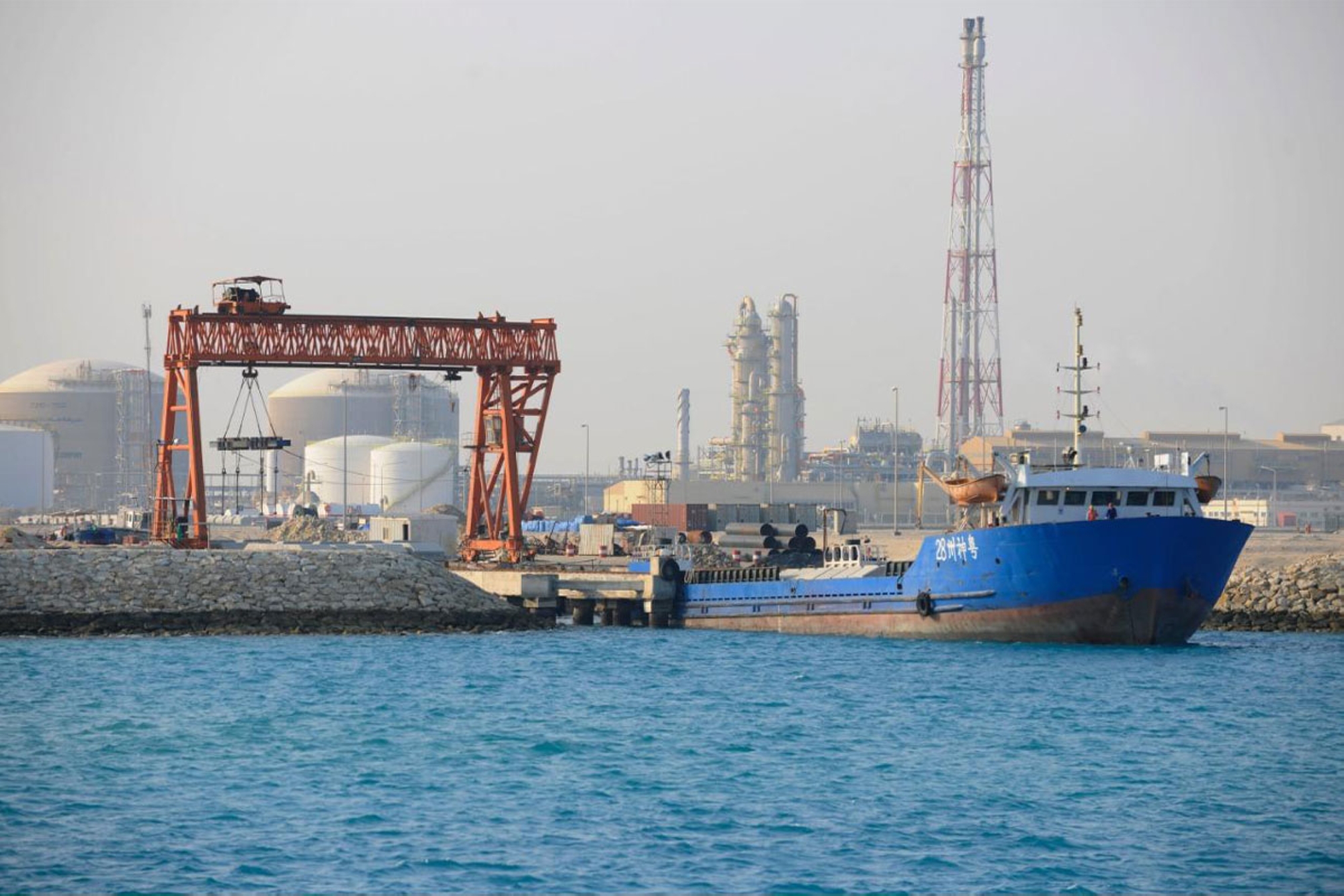
Ports in Saudi Arabia
The ports of the Kingdom overlook vibrant and extensive maritime coasts, serving as major hubs for large shipping companies and logistic services. The Kingdom includes several ports, namely: Jeddah Islamic Port, King Abdulaziz Port in Dammam, King Fahd Industrial Port in al-Jubayl, Yanbu Commercial Port, King Fahd Industrial Port in Yanbu, al-Jubayl Commercial Port, Ras al-Khair Port, Jazan Port, Ras Tannurah Port, and al-Khafji Port.
Maritime trade in Saudi Arabia
Maritime trade in the Kingdom constitutes about 75 percent of the total non-oil trade in the country. Therefore, the Kingdom has contributed to the development of its maritime network, with ports having an annual capacity of approximately nine million containers and receiving eleven thousand ships each year.
The maritime transport network in the Kingdom hosts ten major ports dedicated to non-oil trade, along with 240 docks located at shipping intersections. The Kingdom is the only country among the Gulf Cooperation Council states whose coasts overlook two seas through which one-third of the world's oil shipments and 12 percent of global trade pass.
Causeways in Saudi Arabia
On the eastern coast, the King Fahd Causeway serves as the only land passage connecting the Kingdom and Bahrain. Stretching approximately twenty-five km from al-Azizia area in al-Khobar city, it was once the longest bridge in the Middle East and the second longest globally. Its construction aimed to strengthen ties between the two countries across various domains.
The King Salman Causeway project is situated on the western coast, connecting the continents of Asia and Africa, specifically linking the Kingdom with the Arab Republic of Egypt. This project aims to enhance trade exchange between the two countries and support their exports. Moreover, it serves as an international gateway for various projects and a significant passage for Hajj and Umrah pilgrims and tourists. Additionally, the causeway creates employment opportunities for the local community.
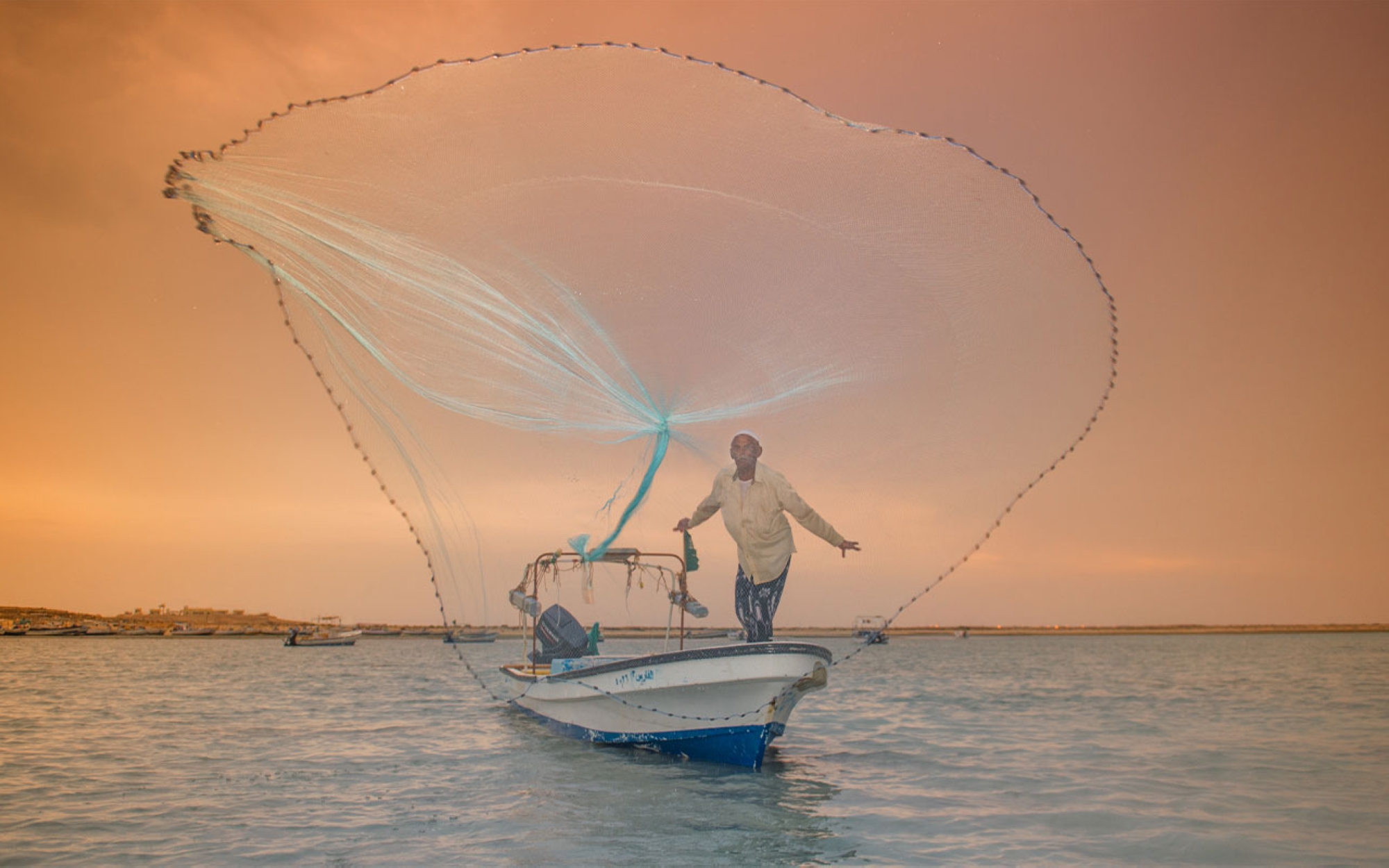
Fishing on the coasts of Saudi Arabia
Fishing in Saudi Arabia
The profession of fishing is one of the oldest trades practiced by ancestors in the Kingdom, passed down through generations. It contributes to providing one of the essential food sources for humans. However, this type of profession requires hard work, patience, and perseverance. It is noticeable in the local fish markets that local produce is scarce compared to imported fish. The Kingdom's production from marine fishing is estimated at seventy thousand m from the Red Sea and the Arabian Gulf, which accounts for about 30 percent of domestic consumption. This shortage is attributed to the lack of interest among youth in fishing. This reluctance stems from several factors such as the demanding nature of the work, the inherent risks involved, the lack of training institutes, climatic factors, and the scarcity of incentives such as health insurance and retirement benefits in the profession.
The Saudi Ministry of Environment, Water, and Agriculture has shown interest in developing the profession of fishing by launching the "Sayad" application. This application targets the youth in the Kingdom, aiming to encourage and enable them to pursue a career in fishing. Additionally, the ministry has worked on suspending new permits for foreign fishermen, ensuring that this profession is restricted to Saudi nationals.
Law of Fishing in Saudi Arabia
The Ministry of Environment, Water, and Agriculture oversees all fishing and diving activities and contributes to their regulation. It works on developing and investing in this sector, alongside protecting the living aquatic wealth in the Kingdom's territorial waters. The ministry also encourages work in this sector and collaborates with the National Center for Wildlife to develop fishing methods. This includes identifying regional fishing areas, determining suitable coastal locations for aquaculture projects, specifying marine organisms prohibited from fishing, and identifying prohibited fishing methods, equipment, and techniques.
Water desalination plants in Saudi Arabia
The Kingdom has witnessed rapid development across all its economic, cultural, and industrial aspects, accompanied by an increase in its population. This has led to a growing demand for potable water due to insufficient natural water sources. Therefore, the Kingdom turned to seawater desalination, as it overlooks the coasts of the Red Sea and the Arabian Gulf. The beginning of water desalination in the Kingdom dates back to the era of the founder King Abdulaziz Bin Abdulrahman Al Saud in 1926 in the city of Jeddah. The aim was to meet the water needs of pilgrims and the residents of Jeddah. With the expansion of desalination projects in the Kingdom, it has become the world's largest producer of desalinated seawater.
After the expansion of the seawater desalination field in the Kingdom, it now hosts about thirty-three desalination plants along its coasts, including nine on the Arabian Gulf coast and twenty-four on the Red Sea coast. These plants supply the Kingdom with 6.3 million m of water daily, equivalent to 70 percent of the desalinated water production.
Tourism on the coasts of Saudi Arabia
Coastal areas are classified as tourist attractions in the Kingdom due to their diverse nature and environment along their length, ranging from soft sandy beaches to mountain peaks, diverse vegetation, and coral reefs. Among the tourist destinations located on the coasts of the Kingdom are:
NEOM Project
NEOM is a term that refers to the new future, and it's an area located in the northwest of the Kingdom, covering an approximate total area of 26,500 km². It enjoys a moderate climate and diverse topography, including beaches with a coastline estimated at 468 km. It also includes forty-one islands, along with snow-capped mountains in the winter season and residential facilities. Additionally, the region hosts several cities, such as The Line, Oxagon, and Trojena.
NEOM is one of the areas concerned with the concept of the knowledge economy, encompassing around fourteen economic sectors, including: technology and digital sciences, education, research and innovation, construction and design, culture and entertainment, food, energy, water, financial services, tourism, sports, manufacturing, media, health and wellness, biotechnologies, and transportation.
Red Sea Project
The Red Sea Project represents one of the tourist destinations in the Kingdom, located in the cities of Ummlujj and al-Wajh on the western coast of the Red Sea. Its total area is estimated at 28,000 km², encompassing lagoons and an archipelago comprising around ninety islands. Additionally, it features dormant volcanoes, dunes, and towering mountains. The project also includes heritage, cultural, and historical landmarks, as well as hotels, residential units, and recreational areas.
Amaala Project
A tourist destination that combines culture, art, and physical wellness, the project is located on the northwestern coast of the Kingdom. It includes various facilities, such as hotel rooms, residential villas, apartments, and diverse homes, in addition to recreational sites, a yacht club, and a world-class institute specializing in marine life.
King Abdullah Economic City
King Abdullah Economic City is located on the Red Sea coast, covering an area of approximately 181 million m². It is one of the important economic cities locally and globally, hosting industrial and logistics clusters with advanced technology. Additionally, it is home to King Abdullah Port and includes tourism and entertainment facilities.
Related quizzes
Related articles

